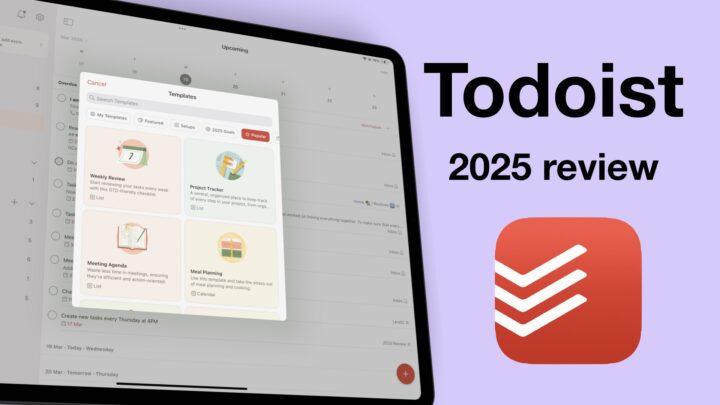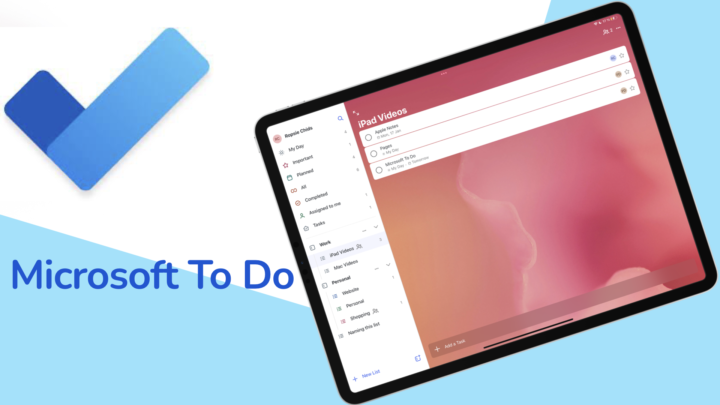Todoist is a to-do app by Doist Inc. It’s available on macOS, Windows, Linux, iPadOS, iOS, and Android, and has a web app. It’s a freemium app that is free to use, with a Pro version for $5/month if you’re an individual and $8/user/month for businesses. It’s cheaper to pay per year. Is Todoist the right app for you and your team, let’s find out. This review focuses on the free web version, using Google Chrome.
Creating to-dos
Adding a new task is fairly straightforward. Todoist is a minimalist app, which makes it easy to figure out. You can name your task, and add a description. Interestingly, you can format your title to make it bold, or italic. You can also add code and links to it. We have never seen that before. It’s cool.
Your description also supports similar formatting options, as well as headings, quotes, and lists (both numbered and unnumbered ones). A detailed description is important to have for a to-do app. You can then add a due date and time, for which you can choose a time zone. You have to type in your time, which is faster than what we’ve seen in other apps.
Flag colours and their names for priorities (in Todoist) are odd. Priorities are usually high, medium, or low. Tags make more sense in the app. They, at least, add important details to your task. They are a decent alternative to priorities.
Reminders are a Pro feature. There are some on our team, without mentioning any names, that turn off all their notifications for all the apps on all their devices. They won’t have a problem with that limitation. Let’s hope the developers can make Pro features easier to identify.
For repeating tasks, Todoist’s approach is unique in that it only supports natural language. Natural language is usually something extra, an additional feature to the ‘traditional setup’. After some time, always typing sentences, “every Friday at 2 pm”, becomes exhausting. Besides, Todoist’s natural language support is still quite limited. We should just have the repeat options available for scrolling through to set what we need. We love typing for time, not so much for repeat cycles.
Marking tasks as complete removes them from the list. You can choose to show completed tasks that display struck out and dimmed. It’s easy to differentiate them from incomplete tasks. We just love apps that know how to scratch out completed tasks!
Creating lists
A project, in Todoist, is a list of your to-dos. You can name it, pick a colour, and view for it. Your view can either be a list or a board; depending on your preferences. You can also group and sort the to-dos in your list according to different criteria. Projects are very simple in Todoist.
Collaboration
You can collaborate on your projects, with up to five people if you’re using the free version of Todoist. It’s easy to invite people to new projects if you’re already working with them. Everyone you invite has full control over the project, so they can do pretty much everything you can. That includes removing you from your own project. This is the worst collaboration feature we have seen in any app so far.
You can assign tasks to your team members and they can assign you to-dos as well. Todoist doesn’t have an “assigned-to-me” smart list for quickly accessing to-dos your team delegates to you. You can create a filter for it though, which is a decent workaround.
Your comments (on tasks) have formatting options, which makes them handy for teamwork. You can also attach any document that is less than 5 MB and, record an audio of less than four minutes. It helps when your team can start a conversation on to-dos you’re working on.
Organisation
Projects, sections & subtasks
We have mixed feelings about Todoist’s organisation system. Your subtasks can be as detailed as your main task, which we love. The app also supports subtasks within subtasks. One subtask level is usually enough. Only the list view shows subtasks below their main tasks. It’s also easier to rearrange your task in this view. However, even with the indentation, it’s not very easy to see the distinction between main and sub-tasks. Sections make more sense than subtasks in Todoist.
Your projects can have sub-projects as well; up to four levels (which, again, is overkill for a to-do app). Above them, you have a few basic smart lists that are easy to figure out. Inbox contains all your tasks that don’t belong to any project.
Filters & Labels
Filters & Labels are supposed to help you create custom smart lists. However, you encounter the typing problem, which makes them difficult to use. It feels a bit like coding, for most of us. Because it comes with codes and formats that you need to know to use them. This is something you’ll only bother learning once you have decided to use Todoist as your main to-do app. For this reason alone, we would not use the app, because Apple Reminders makes this so much easier.
Todoist uses a unique nomenclature, which in our opinion is just wrong names. It calls lists, projects; and tags are labels. You can name, and pick colours for them. The tags are universal, so they are available for every task you create.
You can mark different items as favourites in Todoist.
- projects
- tags (or labels as they call them)
- filters, all of which makes sense.
Searching
Searching in Todoist is fairly simple. You can search through projects, tasks, filters, and tags. However, detailed results are only available for tasks and comments. It seems we need to go back to that query coding stuff, to get the most out of search. Just thinking about it is exhausting.
Productivity tracker
The productivity tracker is a tracking feature in Todoist, that keeps track of all your completed tasks. You can easily view them and the app groups them according to when you completed them. You also have some filters to see your activity in the app, which can be quite helpful.
Your productivity tracker shows your daily and weekly goals, as well as karma levels. You can set these daily and weekly targets yourself and can choose the days you want to rest. Karma is a motivation system that rewards you with points as you complete tasks to reach your daily and weekly goals. You also earn points for using advanced features in the app, which can motivate you to learn how to use slightly difficult features. We love the idea of karma points in Todoist, it just makes you a little bit more excited about getting things done.
The productivity tracker displays a summary of what you have completed and colour-codes it according to your projects. It would be helpful if it had some information pop up when we hover over a colour.
PROS
- formatted titles for tasks
- set goals
- simple and minimalist.
CONS
- no permissions for collaboration
- reminders need a subscription
- difficult repeating tasks
- confusing priorities.
Verdict
For what it’s used for, Todoist has complicated features that other apps (in the same category) have simplified. Find out if the paid version’s worth paying for.




